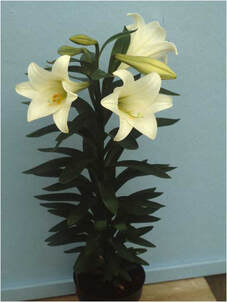
1. After the flowers have faded, remove the flower stalk so that energy does not go into making seed.
2. Keep the plant inside until the danger of frost is past. Keep soil moist but never waterlogged. Don’t allow water to sit in the tray. Continue to fertilize.
3. The pot can be moved outside when frost is no longer a concern. Sinking the pot into the soil up to the brim and placing in dappled shade will help reduce watering. Continue to water and fertilize until the top growth dies down.
4. Choose a sunny, well-drained spot for planting. Good drainage is vital for lilies and so the addition of organic matter is usually necessary for most soils. Till or dig the soil 6 inches deep and add 3 inches of peat moss. Mix the soil and peat moss together. This will form a berm that should drain very well.
5. Plant the bulbs 6 inches deep and 12 to 18 inches apart and water in well. Mulch to conserve moisture. New growth may appear later in the summer or the plant may stay dormant until the following spring.
6. Cover the plants in the fall after the foliage has died down with straw, pine needles, wood chips or other types of mulch to help protect the plant over winter. Use 4 inches of straw or 3 inches of any of the other materials.
7. Uncover the plants in the spring to allow new growth to appear and fertilize according to soil test. (Ward Upham)
 RSS Feed
RSS Feed
